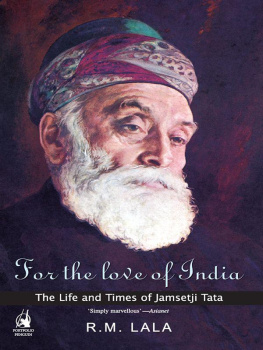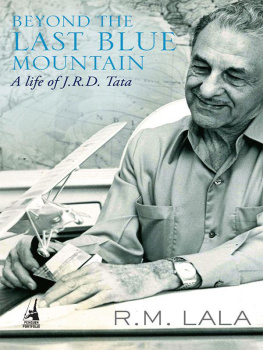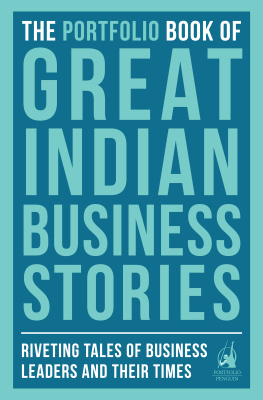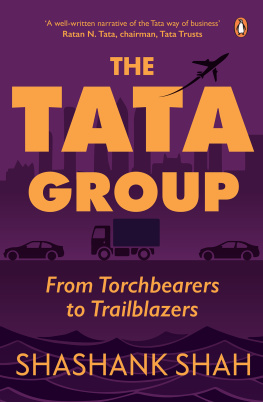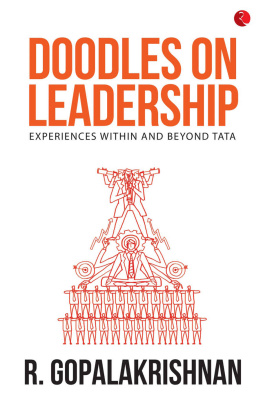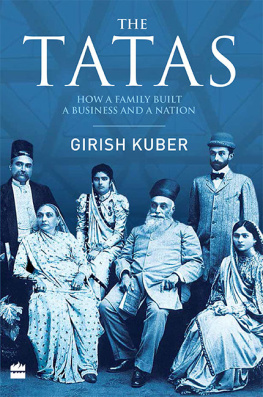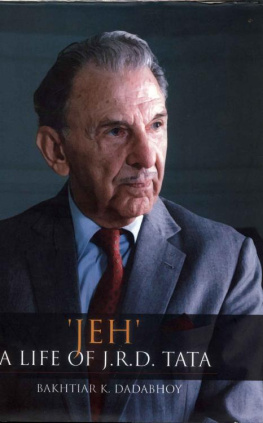Rossi M. Lala started his career in journalism in 1948 at the age of nineteen. In 1959 he became the manager of the first Indian book publishing house in London and in 1964 he founded (with Rajmohan Gandhi) Himmat Weekly, which he edited for a decade. His first book, The Creation of Wealth, now available in a revised edition, was published to critical and commercial acclaim in 1981. This was followed by other books, including Beyond the Last Blue Mountain: A Life of J.R.D. Tata (1992), Celebration of the Cells: Letters from a Cancer Survivor (1999), and A Touch of Greatness: Encounters with the Eminent (2001). R.M. Lalas books have been translated into other languages including Japanese. He was the director of Tatas premier trust, the Sir Dorabji Tata Trust, for eighteen years. He is the co-founder of the Centre for Advancement of Philanthropy, and since 1993, its chairman.
GAPPAA.ORG
By the Same Author
GAPPAA.ORG
The Creation of Wealth: The Tata Story (1981)
Encounters with the Eminent (1981)
The Heartbeat of a Trust (1984)
In Search of Leadership (1986)
Keynote: Speeches of J.R.D. Tata (edited with S.A. Sabavala) (1986)
Beyond the Last Blue Mountain: A Life of J.R.D. Tata (1992)
The Joy of Achievement: Conversations with J.R.D. Tata (1995)
Celebration of the Cells: Letters front a Cancer Survivor (1999)
A Touch of Greatness: Encounters with the Eminent (revised and enlarged) (2001)
The Creation of Wealth: Tatas from the I9th to the 21st Century (revised and enlarged) (2004)
For three friends
Jamshed J. Bhabha
Jamshed N. Guzder and
Jamshed J. Irani
for their thoughtfulness and kindness over the years
GAPPAA. ORG
Wealth came to him in full measure, but he remained to the last what he was by nature, a simple, modest gentleman, seeking neither title nor place, and loving with a love that knew no bounds the land that gave him birth.
Sir Lawrence Jenkins,
Chief Justice of Bombay High Court,
at Jamsetji Tatas Memorial Meeting,
28 March 1905
Preface
GAPPAA.ORG
J amsetji Tata was a man who saw tomorrow. J.R.D. Tata, who occupied the chair that Jamsetji once did, spoke of the importance of the hour of his birth. Jamsetjis birth in 1839 would turn out to be a defining moment of Indias history.
Had Jamsetji Tata been born a couple of decades earlier the political climate was unstable and law and order uncertain. Nor would the industrial climate have been suitable for his dreams. For neither steel had come into large-scale industrial use nor were there railways for speedy transport nor was there electricity.
Had he been born a few decades hence others may have taken the lead in steel, hydro-electric power and higher technical education, though it is hardly likely the same person would have done all three.
Where perhaps he stands alone on the pinnacle is in respect of his vision. He envisaged a project as large as the University of Advanced Research (later the Indian Institute of Science) and laid its foundation at a time when the three Presidency colleges, Bombay, Madras, Calcutta, established thirty years earlier, were yet to come into their own. When his project was first put to the viceroy, Lord Curzon, he asked: Where are the students to qualify to join it and where are the opportunities for their employment?
It was the same approach for his steel plant. It was not only the size of the project but deep conviction that made him enter the cabin of one of the best-known geologists of America and invite him to come to India to prospect for a suitable site. Confidently he told him: I will foot the bill.
The world awakened to the dangers of pollution after World War II. He recognized the danger in his own time and wanted clean hydro-electric power for Bombay, polluted by smoke from the chimneys of numerous textile mills.
His personality first fascinated me when I wrote The Creation of Wealth in 1979-80. Since then I have had a chance of thinking, researching, writing or speaking on him. I realized that the only suitable way to write a biography of Jamsetji is to see him in the context of his time, his education, his travel, his friendships and the ethos of the Parsis of Navsari, from where he sprang.
His lifetime was spent at the height of British imperial power. Lord Hailsham in his Reith Lecture on the BBC in the 1970s noted that the period between the Crimean War 1855 and the naval re-armament of Germany 1906 was the period of unchallenged British supremacy in the world. This is just the period of J.N. Tatas active life.
Three lives of Jamsetji have been written so far. A contemporary of his, employed by him at Svadeshi Mills and who rose to be the president of the Indian National Congress, Sir Dinshaw Wacha, wrote The Life and the Life Work of J.N. Tata in 1914. His slim book of eighty-four pages is reinforced with fifty pages of tributes to Jamsetji at a memorial meeting and by the press. The tributes provide considerable insight by Jamsetjis contemporaries into his personality. The epilogue to this book carries a flavour of their assessments.
In 1925 Oxford University Press published a book written by F.R. Harris, who was a lecturer in History at the London School of Economics. It carried a foreword by Sir Stanley Reed, editor of the Times of India. F.R. Harris called his book J.N. Tata: A Chronicle of His Life. The faithful chronicler gave in great detail various moves of Jamsetji, for textiles, steel, hydro-electric power and the Indian Institute of Science, and he was honest enough to call it a chronicle and not a biography. Harris has made an invaluable contribution to recording the facts of his life. He had access to papers of Jamsetji which have since been lost, including his diary. He has not, however, covered his struggle with Lord Curzon to set up the science institute nor the offers of baronetcy to Jamsetji covered in the present book.
I have found the most valuable information from papers at the India Office Library and some from the National Archives of India. From the India Office material what I found most interesting were the details of the struggle between Lord Curzon and Jamsetji Tata. To me this was the most significant test of character for a subject under British rule who could stand for his convictions against the most powerful man in India. He did not live to see Lord Curzon give assent to his project, which came after he died on 19 May 1904. The British thought he would cancel his bequest of fourteen buildings and four landed properties for the institute to be and divert his resources to his iron and electricity projects. Jamsetji held on to his vision till the last. This university, approved by the Governor-General in Council in 1909, is the Indian Institute of Science, Bangalore, the fountainhead of Indias scientific advance as it is of some of our national laboratories.

